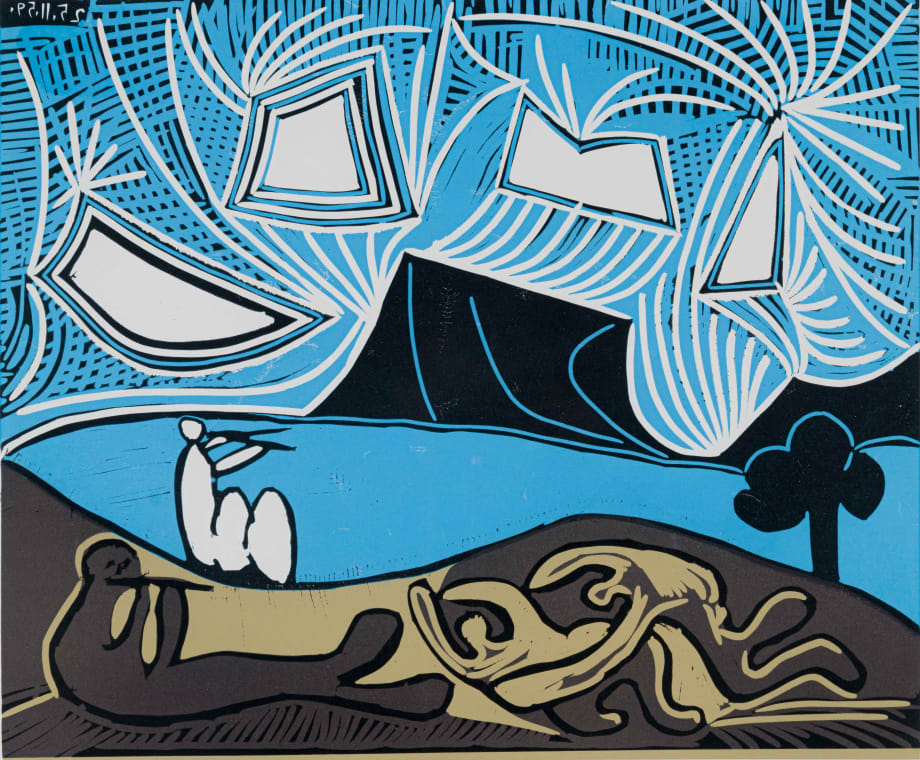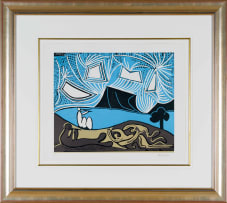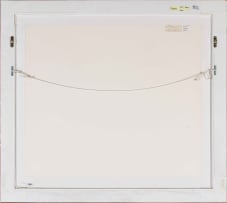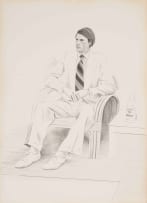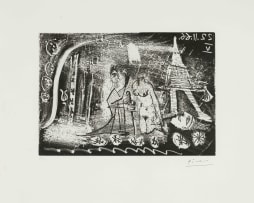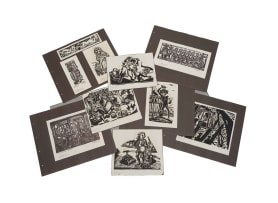Couple et Flûtistes au Bord d’un Lac (Bacchanale) (Couple and Flutists by the Lake) (Bloch 930) (Baer 1259)
Pablo Picasso
Incl. Buyer's Premium & VAT
About this Item
dated 25.11.59 in the image; signed and numbered 25/50 in pencil in the margin
Notes
Printed by Hidalgo Arnéra, Vallauris, France and published by Galerie Louise Leiris, Paris.
Couple et Flûtistes au Bord d’un Lac belongs to Pablo Picasso’s celebrated late series of linocuts produced in the south of France, where the artist’s experimentation with printmaking reached new heights of innovation. Picasso, in his late 70s, remained as daring, playful, and technically inventive as ever in his work. Having only embraced the linocut medium a few years earlier, it served as the perfect vehicle for his relentless curiosity and desire to simplify form while amplifying expressive power.
This work takes as its theme the Bacchanal, that classical celebration of Dionysian revelry and erotic freedom, a motif Picasso revisited throughout his career as a metaphor for artistic creation itself. The composition unfolds in bold, flat planes of colour – vivid blue, ochre, and black, animated by rhythmic, almost lyrical lines. The scene juxtaposes reclining figures and a goat, their forms stylised to the brink of abstraction, with an enigmatic spectator seated nearby. The sky above bursts with energy, filled with dynamic white shapes that recall both the Mediterranean sun and the exuberant vitality of the ancient myths Picasso so enjoyed reinterpreting.
Formally, the image exemplifies Picasso’s mastery of the linocut process, and the reduction method in particular, in which a single block is successively cut and printed in layers of colour. Each stage of carving permanently removes material from the block, making the process both irreversible and remarkably demanding. The resulting image combines sculptural precision with painterly immediacy, a synthesis that underscores Picasso’s ability to bridge the boundaries between media. The crisp contrasts and graphic vitality of Couple et Flûtistes au Bord d’un Lac showcase the confidence of an artist who had fully internalised the language of modernism and could manipulate it with effortless fluency.
Thematically, this print resonates with Picasso’s lifelong engagement with classical antiquity. Since the 1920s, he had reimagined the mythic world of fauns, satyrs, and nymphs as allegories for sensual pleasure and creative instinct. In Couple et Flûtistes au Bord d’un Lac, these ancient figures appear transfigured through the lens of modern abstraction, their joyous abandon rendered through line and colour rather than naturalistic description. The reclining bodies in the foreground suggest both the languor of the siesta and the timeless intoxication of the Bacchic rite, while the spectator, perhaps an avatar of the artist himself, looks on as if bearing witness to the eternal dance between passion and art.
Picasso’s linocuts of this period were printed in small editions of fifty, each personally signed and numbered by the artist. They remain among the most sought-after examples of his late printmaking, prized for their technical brilliance and distilled vitality. Couple et Flûtistes au Bord d’un Lac represents the spirit of Picasso’s late years: a fearless synthesis of modernity and myth, executed with wit, economy, and exuberant energy.
1Catherine Daunt (2025) Picasso: Printmaker, London: The British Museum.
Literature
George Bloch (1971) Picasso: Volume I: Catalogue of the Printed Graphic Work 1904-1967, Berne: Editions Kornfeld et Klipstein, another impression from the edition illustrated in black and white on page 202, cat. no. 930.
Brigitte Baer (1992) Picasso Peintre-Graveur, Tome VI: 1966–1968, Berne: Edition Kornfeld, cat. no. 1259.
